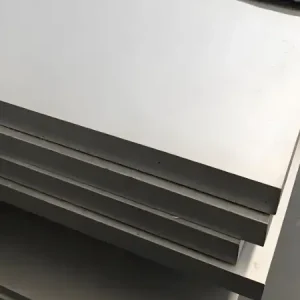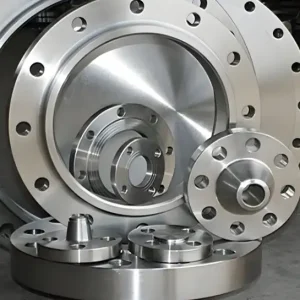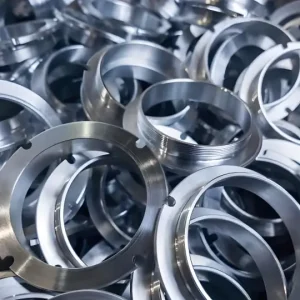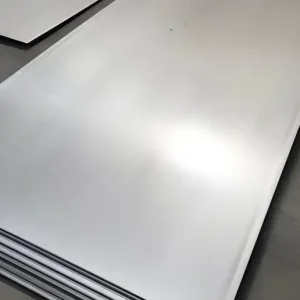AR500 steel is a through-hardened, quenched & tempered abrasion-resistant plate with a nominal Brinell hardness near 500 HBW, engineered to deliver outstanding wear resistance and impact toughness for heavy-duty applications such as mining liners, ballistic/target plates, and heavy equipment wear parts. For buyers who need factory-direct supply, MWAlloys offers China-sourced AR500 sheet and plate at competitive, 100% factory pricing with ready stock for common sizes (including 4×8 sheets) and fast shipment from our inventory.
What is AR500 steel?
“AR” stands for abrasion-resistant. The number 500 refers to a nominal Brinell Hardness Number (BHN) target — roughly 500 HBW — measured per Brinell test methods. In practice, many suppliers specify ranges (commonly ~460–540 HBW) and produce AR500 in a quenched & tempered condition to balance surface hardness with bulk toughness. AR500 is a trade/industry classification rather than a single formal ASTM grade.
Typical chemical composition
Different mills and brands adjust composition to hit target hardness and toughness. Below is a commonly quoted “typical” chemistry used for AR500 production; use it only for ordering reference and request mill test reports (MTRs) from suppliers for exact values.
| Element | Typical content (wt %) — representative |
|---|---|
| Carbon (C) | 0.26 – 0.40 |
| Manganese (Mn) | 0.60 – 1.20 |
| Silicon (Si) | 0.20 – 0.80 |
| Chromium (Cr) | 0.30 – 0.80 |
| Nickel (Ni) | 0.20 – 1.00 |
| Molybdenum (Mo) | 0.10 – 0.60 |
| Phosphorus (P) | ≤ 0.025 |
| Sulfur (S) | ≤ 0.005 |
(Representative data; ranges vary by mill and product family—always confirm MTR.)
Mechanical properties and hardness
-
Nominal hardness: “500” indicates a target Brinell hardness close to 500 BHN; typical commercial ranges are ~460–540 BHN depending on thickness and mill practice.
-
Toughness & ductility: Quench and temper cycles are controlled to provide adequate toughness — AR500 sacrifices some formability in exchange for wear resistance. Many AR grades still retain useful elongation (single-digit to low-teens % values depending on thickness).
-
Testing standard: Brinell hardness testing is commonly reported in accordance with ASTM E10 (Standard Test Method for Brinell Hardness of Metallic Materials). When ordering, request hardness maps and the test method used.
How AR500 is manufactured
Typical manufacturing steps:
-
Chemistry control: Mill sets target chemistry to achieve hardenable microstructure.
-
Hot rolling: Slabs are hot-rolled to plate thickness.
-
Quench & temper: Plate is heated to the austenitizing temperature, rapidly quenched to form martensite (or martensite/bainite mix), then tempered to reduce brittleness while preserving hardness. This step is the key to “AR” behavior.
-
Quality checks: Hardness testing (ASTM E10), dimensional checks (ASTM A6 general requirements), and chemical analysis/MTR.
Thickness & weight chart (useful for 4×8 sheet planning)
Steel weight per square foot for 1" thick approximates 40.82 lb/ft² (steel density ~490 lb/ft³). Use that multiplier to compute sheet weight.
| Thickness (in) | Thickness (mm) | Weight lb/ft² | Weight per 4×8 sheet (32 ft²) |
|---|---|---|---|
| 3/16 (0.1875) | 4.76 | 7.65 | 245 lb |
| 1/4 (0.25) | 6.35 | 10.21 | 326.6 lb |
| 3/8 (0.375) | 9.53 | 15.31 | 489.9 lb |
| 1/2 (0.5) | 12.7 | 20.41 | 653.1 lb |
| 3/4 (0.75) | 19.05 | 30.62 | 979.8 lb |
| 1.0 | 25.4 | 40.82 | 1306.2 lb |
| 1.25 | 31.75 | 51.03 | 1632.9 lb |
| 1.5 | 38.1 | 61.23 | 1959.4 lb |
| 2.0 | 50.8 | 81.64 | 2612.5 lb |
(Calculation basis: weight per ft² = thickness (in) × 40.82 lb/ft² per inch.)
Specifications, tolerances and what to request when you buy
Because “AR500” is an industry name, always specify and confirm the following with your supplier:
-
Hardness range and test method: e.g., Brinell 460–540 HBW, per ASTM E10.
-
Chemical certificate (MTR): exact element percentages.
-
Heat treatment condition: Quenched & Tempered, tempering temperature range.
-
Thickness tolerances & flatness: per ASTM A6 (or mill’s tighter tolerance if requested).
-
Dimensional cuts and edge condition: Whether plates are mill edge, rough cut, or flame-cut and any beveling.
-
NDT or mechanical tests: Charpy (if required), tensile/yield (if required), hardness mapping.
-
Coating or corrosion protection: AR steels are susceptible to corrosion; specify if galvanizing, priming, or painting is needed.
AR500 vs AR600
| Feature | AR500 | AR600 |
|---|---|---|
| Nominal BHN | ~500 (typical 460–540) | ~600 (typical 580–625) |
| Primary benefit | Balance of wear resistance and toughness; widely used | Higher wear resistance; used where extreme abrasion or ballistic resistance required |
| Formability | Low — less workable than AR400 | Lower — more brittle risk, especially in thin sections |
| Common uses | Targets, liners, hoppers, mining, wear parts | Ballistic plates, extreme wear linings, specialized armor |
| Fabrication caution | Can crack if bent or poorly welded; preheat and proper consumables needed | Higher risk of cracking; needs stricter welding and heat-control procedures |
Because AR600 is harder, it can give longer wear life but increases risks (brittleness, welding difficulty). Choose by application and perform trial evaluations.
Typical applications and industry examples
-
Ballistic targets and armor plates (shooting ranges, protective shields).
-
Mining equipment linings: chutes, hoppers, crushers, conveyor skirts.
-
Aggregate and bulk-material handling: dump truck bodies, dump liners.
-
Wear components in cement, steel, and aggregate plants.
-
Specialty tooling and heavy-duty wear parts for construction or demolition equipment.
Fabrication, cutting, and welding notes
-
Cutting: Plasma or oxy-fuel for thick plates; flame/plasma will form a hard HAZ — plan post-cut heat treatment or grinding if required.
-
Welding: AR500 can be welded, but microstructure and hardness near the weld may change; use low-hydrogen electrodes, preheat and controlled interpass temperatures for thick sections; consumable selection matters (use filler metals designed for Q&T steels). Test welds and perform hardness checks in the HAZ.
-
Bending & forming: Limited — AR500 is not highly formable; cold bending risks cracking. Consider machining or laser cutting plus welded assemblies.
-
Safety: Grind or machine with dust control — AR steels produce hard particulates. Use PPE and local exhaust ventilation.
AR500 4×8 Steel PlatePrice Comparison 2025 (USD per sheet)
| Thickness | Typical 4×8 weight (lb) | USA (retail / distributor) | China (factory / FOB or bulk) | Europe (distributor / importer) |
|---|---|---|---|---|
| 3/16" (0.1875") | ≈ 245 lb | $150 – $300 (marketplace & small-qty retail examples). | $50 – $90 (bulk factory / per-ton quotes converted to per-sheet; common China listings show low per-ton pricing for bulk). | $200 – $400 (smaller retailers & EU import premiums). |
| 1/4" (0.25") | ≈ 326.6 lb | $400 – $700 (typical distributor / marketplace ranges for certified AR500 sheets). | $70 – $115 (bulk FOB/ex-works equivalents from Chinese quotes converted from $/ton ranges). | $500 – $900 (European sellers / importers, certification raises price). |
| 3/8" (0.375") | ≈ 489.8 lb | $400 – $950 (retail examples: single-sheet listings vary — e.g., midpoints around $500–$700; some retailers list $600+). | $105 – $172 (China bulk / per-ton conversions produce lower per-sheet numbers for bulk orders). | $600 – $1,200 (European distributor pricing and freight / VAT markups). |
| 1/2" (0.50") | ≈ 653.1 lb | $700 – $1,400+ (retail/distributor—thicker plates carry a sizeable premium; small-qty certified sheets cost more). | $140 – $230 (bulk factory per-sheet equivalents from low per-ton quotes). | $900 – $1,600+ (EU distributors; wide variance from supplier certs / small orders). |
Quality control and recommended tests
-
Full MTR (mill test report) with chemical analysis and heat number.
-
Brinell hardness mapping (ASTM E10) across plate surface and edges.
-
Tensile/yield data if component is structural or used under load.
-
Dimensional inspection to ASTM A6 or agreed tolerances.
-
Third-party inspection available for large orders or critical service parts (charpy, UT, PMI).
FAQs
-
What is AR500 steel used for?
AR500 is used where sliding abrasion and impact occur: ballistic targets, mining liners, hoppers, crushers, and heavy-wear machine parts. -
Is AR500 bulletproof?
AR500 is used for ballistic targets and some armor applications; ballistic performance depends on plate thickness, hardness, projectile type, and mounting — consult ballistic test data for expected threats. -
Can AR500 be welded?
Yes, but welding requires proper procedures, preheat/interpass control, and suitable filler metals to avoid HAZ cracking. Perform weld trials. -
What does “500” mean in AR500?
It indicates a nominal Brinell hardness target of roughly 500 HBW. -
How much does an AR500 4×8 sheet cost?
Prices vary by thickness and supplier; many China listings show ranges from roughly US$400 to US$830 per sheet depending on thickness and spec—ask for an up-to-date quote. -
Is AR500 standardized by ASTM?
“AR500” is an industry name; hardness testing normally follows ASTM E10 and plate general requirements may reference ASTM A6. Confirm tests and tolerances with the supplier. -
Can I bend or punch AR500 sheet?
Not recommended for tight bends or heavy deformation without special preparation; AR500 has limited formability and can crack. Consider fabricating by welding smaller pieces. -
What are typical hardness ranges for AR500?
Typical commercial ranges: roughly 460–540 BHN. Confirm with MTR and hardness maps. -
How do I choose between AR500 and AR600?
Choose AR600 only if you need maximum surface hardness and are prepared for more difficult welding and higher risk of brittle failure; for many cases AR500 strikes the best balance. -
Can MWAlloys supply certified AR500 with testing documents?
Yes, MWAlloys supplies factory-direct AR500 plates with MTRs, hardness maps, and inspection photos for most standard sizes; request a sample certificate with your RFQ.
What we supply and why choose MWalloys?
MWAlloys sources AR500 from established Chinese mills and offers:
-
Factory-direct pricing (no trading markup).
-
Stock availability of common sizes (including 4×8), enabling rapid shipment.
-
Documentation: MTRs, hardness maps, and photos.
-
Custom cutting & packaging for export.
If you need a formal quotation, send required thickness, hardness target, quantity, destination port, and desired incoterm; MWAlloys will respond with a detailed FOB/CIF quote and available stock report.
Practical selection tips
-
For wear with impact, choose thicker AR500 with verified toughness.
-
For ballistic use, specify ballistic testing or trusted ballistic suppliers.
-
For welded assemblies, request welding guidelines from the mill and order trial weld coupons.
-
For corrosion environments, plan protective coatings or use corrosion-resistant alternatives (e.g., stainless liners + AR plate backup).
Closing summary
AR500 is a versatile abrasion-resistant plate that delivers strong wear life while retaining useful toughness when processed correctly. Because “AR500” designates a performance target rather than a single rigid specification, buyers must demand MTRs, hardness maps (ASTM E10), and clear heat-treatment records to ensure the material will perform in service. For competitive pricing and stocked availability, MWAlloys can supply AR500 plates with factory pricing and quick dispatch from China; contact us with your full specification for a tailored quote.





